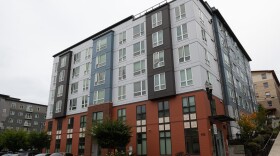Tacoma Rescue Mission is planning to expand its men’s homeless shelter at 425 S. Tacoma Way to roughly three times its current size.
The organization, which is one of the area’s largest providers of shelter for the unhoused, says it has secured funding to increase the number of beds at the shelter from 60 to 180.
Tacoma Rescue Mission director Duke Paulson said the expansion is necessary due to an increased need for shelter beds.
Pierce County’s annual one-night survey of those living homeless in the region counted a roughly 24% increase from the year before. Of the nearly 2,700 surveyed, 54% were living in some sort of shelter, with the rest either living outside, in a vehicle or in an unreported location.
“We are regularly serving 100 to 120 people a night,” Paulson told The News Tribune. “We are trying to respond to an increase in need in the community.”
Paulson said the shelter on South Tacoma Way is at capacity on a nightly basis. The shelter keeps a waiting list. Paulson said the number of those waiting fluctuates depending on the weather and the season, but estimated about 30-40 are waiting on the list during the winter.
Many wait outside the shelter, with vehicles and encampments stretching alongside South Tacoma Way and adjacent green spaces.
According to Tacoma Rescue Mission, the expansion is expected to cost $20 million. Paulson said the project will expand the footprint of the building. He said the organization purchased a gravel lot adjacent to the building from the City of Tacoma in 2021, which will provide room for the project.
Tacoma Rescue Mission also plans to add an additional floor to the building and an additional two bathroom facilities.
Paulson told The News Tribune the project gives the shelter an opportunity to redesign itself, transitioning from the long-held belief that a shelter needs to be a large warehouse-like space with dozens of beds out in the open.
During the pandemic, the women’s shelter portion of the Downtown Campus incorporated separated bunk structures that created a little more privacy and space for those staying there.
“We had the realization over the last few years that we could create a space more dignified, with more privacy,” Paulson told The News Tribune.

The bunks in the women’s shelter include a locker for people to keep their belongings, and outlets are available for people to charge their phones and other electronics. Paulson said the men’s shelter expansion would incorporate elements similar to the women’s shelter.
Paulson said he understands that congregate shelters are becoming a less popular option for those who need shelter, with the lack of privacy being a concern to many who might prefer a tiny home or another form of non-congregate housing.
“We learned a lot,” Paulson said. “We have a chance to rethink traditional shelter models.”
Tacoma Rescue Mission’s grant writer Emily Koo has reported securing $5.5 million from Pierce County for the project, $5 million from the Washington Department of Commerce, $4 million in federal funding, $3.5 million from the City of Tacoma as well as funding from private donors.
Paulson expects the expansion to be completed by the end of 2025, with permitting yet to be approved by the city.
This article was first published by the Tacoma News Tribune through the Murrow News Fellow program, managed by Washington State University.






